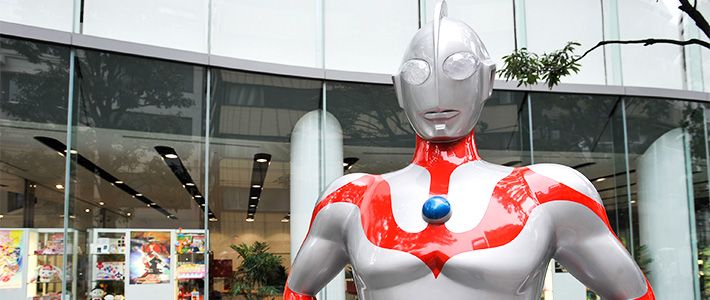
The Tokusatsu Entertainment Genre that Godzilla Spawned
Sympathy for the Monsters: Ultraman’s Minority Perspective
Culture- English
- 日本語
- 简体字
- 繁體字
- Français
- Español
- العربية
- Русский
Tsuburaya Eiji, who brought Godzilla to the world, is also famous in Japan as the father of Ultraman, a 40-meter-tall superhero who comes to earth from the “Land of Light” located somewhere in Nebula M78. The imagination and passion of the writers and staff who worked under Tsubaraya’s direction to produce the first-generation series Ultraman and its sequels Ultra Seven and Kaette kita Ultraman (Ultraman Returns) laid the foundations for a series that has become an indispensable part of Japanese popular culture.
The character first appeared on Japanese television in July 1966. Color TVs had started to become a common feature in regular households at the time of the Tokyo Olympics two years earlier. The new space-age superhero, standing fully 40 meters tall, and his battles with monsters and aliens, captured the imaginations of youngsters throughout the country. Ultraman became a phenomenal success attracting up to 40% of the total TV audience.
No discussion of this classic science fiction hero would be complete without mention of two very different scriptwriters from Okinawa.
Slugs and Sludge
In 1963, Tsuburaya founded Tsuburaya Productions, to create television content in the special-effects-heavy tokusatsu genre. Tsuburaya had previously made his reputation in the film world through working on a series of tokusatsu hits. The company’s first show, Ultra Q, brought a whirlwind of monsters tumbling into the nation’s living rooms, and was a stepping stone to the birth of Ultraman. The chief writer for both series was a scriptwriter from Haebaruchō in Okinawa named Kinjō Tetsuo. Kinjō met Tsuburaya as a student in the literature department at Tamagawa University. Tsuburaya was quick to recognize his potential, and after graduation Kinjō joined Tsuburaya Productions.
Uehara Shōzō, originally from Naha in Okinawa, won a TV award at the 1964 National Arts Festival for his script Shūkotsu (Collecting the Bones) about the Battle of Okinawa. He came to Tokyo at the suggestion of Kinjō, whom he knew from his Okinawa days. He arrived in the capital during the filming of Ultra Q, and remembers a startling encounter.
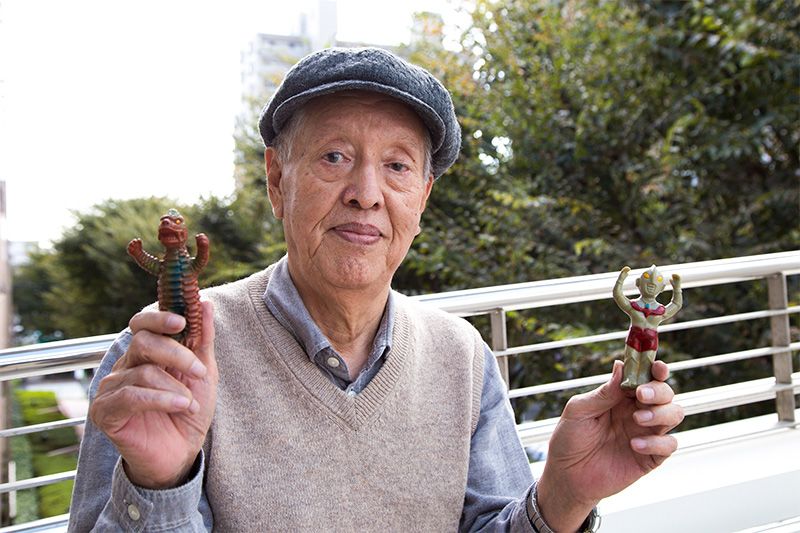 Uehara Shōzō was born in Naha, Okinawa, in February 1937. After graduating from Chūō University in Tokyo he returned to Okinawa for a time due to tuberculosis. He went back to Tokyo at the invitation of Kinjō Tetsuo, supporting him through the creation of Ultraman.
Uehara Shōzō was born in Naha, Okinawa, in February 1937. After graduating from Chūō University in Tokyo he returned to Okinawa for a time due to tuberculosis. He went back to Tokyo at the invitation of Kinjō Tetsuo, supporting him through the creation of Ultraman.
“I was astonished to see a man dressed up in a full-body suit as [space monster] Namegon,” Uehara says. “I’d been writing scripts dealing with the issues of the US bases in Okinawa since my student days. I couldn’t imagine a story about a giant slug from Venus. It was the kind of thing only Kinjō could have come up with. I remember when we were students he started a society called ‘Shake Hands with a Venusian.’ He was always dreaming of the stars.”
Despite his reservations, Uehara agreed to work with Kinjō at Tsuburaya Productions. What he really wanted to do was to write dramas that would tell people the truth about Okinawa, but there were fears of reprisals from the right wing, and in TV circles any kind of antiwar movement or discussion of the Okinawa issue was taboo. And so Uehara agreed to write monster stories for children instead. The first script he came up with was “Oil SOS,” in which a monster emerges from the sewage sludge in Tokyo Bay. Uehara says today that the real-life problem of Minamata disease caused by industrial pollution was in his mind when he wrote the story. “I’m the kind of person who just can’t write unless I have some kind of social issue in mind,” he admits.
Eventually, “Oil SOS” was canceled. The team was denied permission to film by the oil petroleum company that owned the site in Chiba where shooting was scheduled to take place. To make use of the monster costumes that had already been made, Uehara hurriedly wrote a script called “Uchū shirei M774” (Space Directive 774), episode 21 of the Ultra Q series. It marked his professional debut as a writer.
Okinawa: Land of Spirits and Monsters
Ultra Q was broadcast for six months from January 1966. Next came Ultraman. Uehara, who was working in the script department at the time, remembers well the discussions and abandoned ideas the team went through before they hit on the final idea for the famous character. “At first he was a tengu-like figure,” he remembers, referring to the long-nosed creature of Japanese legend. “Then the art director, Narita Tōru, came up with this bearded character who looked like something out of an old Greek myth. But we felt it wasn't right somehow.” After much trial and error, the team finally came up with the character that has become familiar to generations of Japanese children: the sharp-featured spaceman hero with his red-and-silver body.
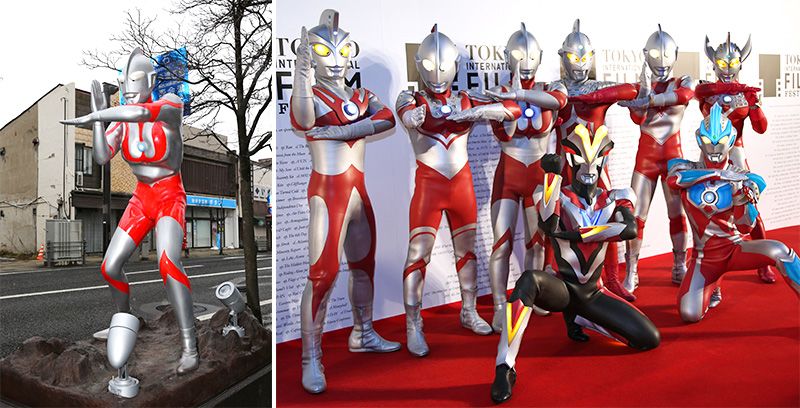 Left: A statue of Ultraman in Tsuburaya Eiji’s hometown of Sukagawa, Fukushima Prefecture, unleashes a dose of Spacium rays. (Photo courtesy of Sukagawa City/© Jiji). Right: Ultra-heroes on parade at the 2014 Tokyo International Film Festival (© Jiji).
Left: A statue of Ultraman in Tsuburaya Eiji’s hometown of Sukagawa, Fukushima Prefecture, unleashes a dose of Spacium rays. (Photo courtesy of Sukagawa City/© Jiji). Right: Ultra-heroes on parade at the 2014 Tokyo International Film Festival (© Jiji).
Kinjō was involved in 14 of the 39 episodes of Ultraman, either as sole writer or as cowriter. “Most people think of the plot first, but for Kinjō it was the monster that came first and then he would fit the story around that.”
“We grew up in Ryūkyū [Okinawa], where there is a long tradition of shamanism and people still have a sense of fear and respect for the spirits and strange creatures that lurk in the shadows. Kami are everywhere in the world of nature. I think Kinjō felt that his monsters were just another kind of kami. And Ultraman comes from the Land of Light. This too is connected to Okinawa folk traditions—people used to believe in a land of light and fertility across the sea called Nirai Kanai.”
Kinjō did not regard monsters as creatures to be driven away or exterminated as quickly as possible. He believed in the idea of balanced coexistence, and felt that monsters had their own raison d’être and their own purpose in life. This sympathetic view resonated with Uehara.
Leaving Tsuburaya Behind
Ultraman was followed by Ultra Seven, first broadcast in October 1967. Of its 48 episodes, one of Kinjō’s stories, Nonmaruto no shisha (Envoy from Nonmalto), stood out in particular. The story dealt with a race of beings who lived under the sea, driven there by humans in ancient times. They protest against human exploitation of the ocean floors, and accuse humanity of being the true invaders, before they are finally destroyed by the Earth Defense Force. The story refuses simple definitions of good and evil, and leaves troubling doubts in viewers’ minds. Where does true justice lie?
In parallel with Ultra Seven, Kinjō was also working on scripts for a new science fiction drama called Mighty Jack. This was a major undertaking for Tsuburaya Productions, an attempt to break into the popular eight o’clock evening slot with programing aimed at adults. But viewing figures were disappointing. This failure led to the closure of the script department, and Kinjō left the company.
Uehara quit soon after, feeling that there was little meaning in staying on now that his mentor and colleague was gone. Kinjō went back to Okinawa, then about to revert to Japan after over 25 years of US control, and invited Uehara to join him in starting a new company to create content with a special Okinawa flavor. But Uehara turned the offer down, deciding to remain in Tokyo and build up more experience as a scriptwriter.
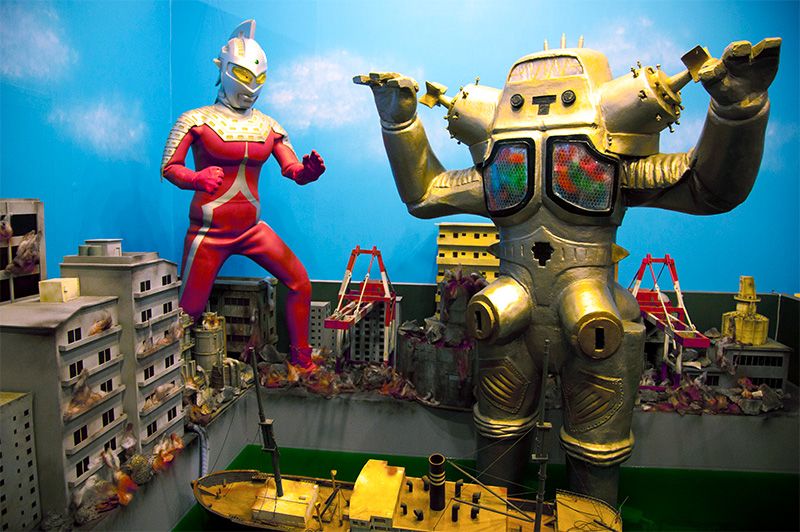 This diorama, displayed at an event in 2012, recreates a scene from “Urutora keibitai nishi e” (The Ultra Garrison Goes West), episodes 14 and 15 of Ultra Seven. The monster, King Joe, is rumored to have been named after its creator, scriptwriter Kinjō. (Photo: Rodrigo Reyes Marin/Aflo)
This diorama, displayed at an event in 2012, recreates a scene from “Urutora keibitai nishi e” (The Ultra Garrison Goes West), episodes 14 and 15 of Ultra Seven. The monster, King Joe, is rumored to have been named after its creator, scriptwriter Kinjō. (Photo: Rodrigo Reyes Marin/Aflo)
Uehara had other reasons for remaining in Tokyo. As a high school student, he learned that his uncles, who had been successful in the capital, had moved their family registers out of Okinawa. “There was a system of discrimination against people from Okinawa, who were regarded as second-class citizens.” It seemed you were less likely to succeed if people knew that’s where you were from. As the islands were not then part of Japanese territory, Okinawans needed a passport to visit Tokyo. During his time in Tokyo as a student, Uehara was struck by the lack of US bases, and felt the discriminatory attitudes toward Okinawa in people around him. But he saw this as a reason to stay and learn more about Yamatonchu, as Okinawans called the mainland Japanese.
He had made many good friends through his work and some producers continued to send work opportunities his way after he went freelance. Eventually he became part of the scriptwriting team that worked on the martial arts hit Jūdō itchokusen (1969–71), and his professional career took off.
Ultraman Returns: An Attempt at Realism
Uehara was also involved in the launch of Kamen Rider, another tokusatsu classic based on a manga work by Ishinomori Shōtarō. When he was working on the script for the first episode, he was contacted by Tsuburaya Productions, and asked to come back and help them to revive the Ultraman character. He ended up working as the chief writer on Ultraman Returns, which ran from April 1971 to March 1972.
“I was quite nervous when they told me that Honda Ishirō, the director who made the original Godzilla, was going to be shooting the first two episodes,” Uehara says. In 1970, Tsuburaya Eiji died and the production team pulled together in solidarity to make something that would honor their mentor’s memory. Uehara decided that he would try something different from Kinjō’s blithely heroic version of the character. “I wouldn't have been able to pull it off if I’d tried. He had always imbued the stories with fantasy elements, so I decided to try and make the character as realistic as possible.”
The hero of the story is Gō Hideki, an ordinary young man and former auto repairman who is a member of the Monster Attack Team (MAT). Episode 33, “Kaijūtsukai to shōnen” (The Monster Keeper and the Boy), is a particularly memorable and controversial episode in which Uehara depicted the seething internal conflicts inside Gō.
The story is set in Kawasaki and details the relationship between a young orphan from Esashi in Hokkaidō and an old man (in fact an alien) who lives in a lean-to by the riverside. The episode depicts widespread discrimination against the two main characters, highlighting the frightening aspects of a mass group mentality. When the old man/alien is shot dead, the monster he has kept sealed underground is released. The citizens scream at Gō to do his duty as a member of MAT and deal with the monster as quickly as possible. But Gō hesitates to transform himself into Ultraman. “You’re the ones who brought the monster on yourselves!” he says.
Uehara says that when he wrote the script he imagined that the young boy from Hokkaidō belonged to the Ainu minority and that the elderly man represented the Zainichi Korean population. As an Okinawan and a member of a minority himself, he felt ineluctably drawn to side with the boy, the alien, and the monster. After the episode was shown, Uehara was moved out of his position as chief writer.
Ultraman as a Folk Tale for the Modern Age
Uehara went on to write scripts for numerous other popular children’s shows, including Ganbare!! Robokon and Himitsu sentai gorenjā (Five Rangers). Kinjō, meanwhile, worked on writing scripts and producing for Okinawan theater after his return home. In 1975 he helped to design and produce the main ceremony for the Okinawa International Ocean Expo, but was hurt when the expo came in for local criticism for its destructive impact on Okinawa’s seas. The following year, he died in a freak accident at the age of 37.
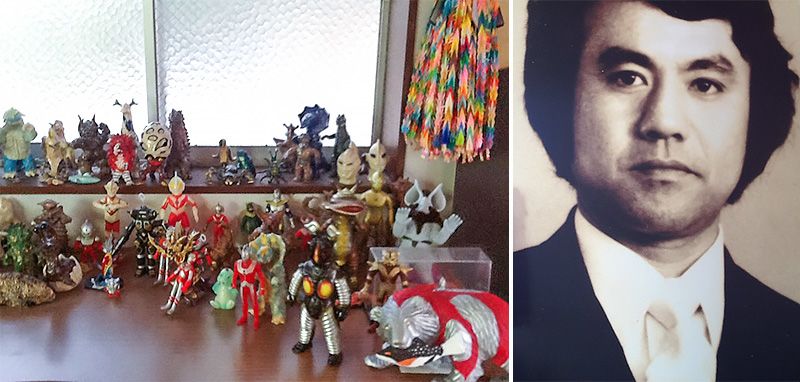 Kinjō Tetsuo (right) was born in Haebaruchō, Okinawa. Today, the grounds of the Shōfūen restaurant house the Kinjō Tetsuo Museum, which used to be the study where he worked. The writer’s desk is decorated with Ultraman figurines left by visiting fans. (Photo: Kinjō Tetsuo Museum)
Kinjō Tetsuo (right) was born in Haebaruchō, Okinawa. Today, the grounds of the Shōfūen restaurant house the Kinjō Tetsuo Museum, which used to be the study where he worked. The writer’s desk is decorated with Ultraman figurines left by visiting fans. (Photo: Kinjō Tetsuo Museum)
This summer, NHK asked fans to vote for their favorite episodes to mark 50 years since the original broadcast. In first place was Kinjō’s final script for Ultra Seven, “Shijō saidai no shinryaku” (The Greatest Invasion in History). Uehara’s “The Monster Keeper and the Boy” was in second place. “Those early series have some really passionate fans, from teens to people in their fifties,” Uehara reflects. “They say they find new meaning in the episodes every time they watch them.” Just as people today find various ways of interpreting old Japanese folk tales like Momotarō, Princess Kaguya, and Urashima Tarō, Uehara hopes that Ultraman too will be passed on as a classic that belongs to everyone, bringing its message of tolerance and wonder to each new generation.
(Originally published in Japanese on November 29, 2016. Interview and text by Itakura Kimie and Ōtani Kiyohide of Nippon.com. Banner photo: Ultraman stands guard outside Bandai headquarters. Tsuburaya Productions entered a capital and business alliance with Bandai in 2008.)